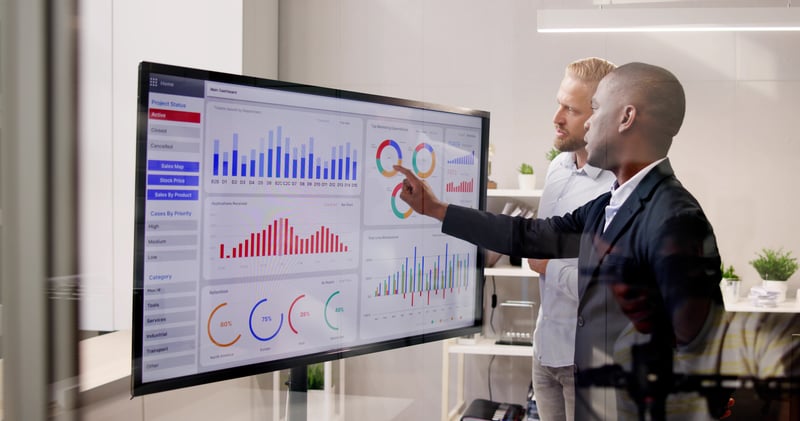For every IT leader, securing your cloud environment is not just an option-it's a necessity. Microsoft Azure, a leading cloud service provider, offers robust security features designed to protect your data, applications, and infrastructure from potential threats. However, leveraging these features effectively requires a strategic approach. This article will help guide IT leaders at small to midsize businesses through the best practices for mastering Azure security, ensuring your cloud environment is both resilient and compliant.
Introduction to Azure Security

Since its inception in 2010, Azure has rapidly evolved, expanding its offerings to include more than 200 products and services designed to provide comprehensive solutions for computing, networking, databases, analytics, artificial intelligence, and Internet of Things (IoT), among others. Azure's significance in the small and medium-sized business (SMB) sector cannot be overstated. For SMBs, the adoption of Azure signifies a strategic move towards scalability, flexibility, and efficiency, without the substantial upfront costs associated with traditional IT infrastructure. By leveraging Azure, SMBs can access enterprise-level technology, enabling them to compete more effectively in their respective markets.
IT leaders within SMBs are increasingly recognizing the value that Azure brings to their operations. By integrating Azure into their IT strategy, they can achieve:
- Cost Efficiency: Azure's pay-as-you-go pricing model allows SMBs to control costs while accessing cutting-edge technology. This model eliminates the need for significant capital expenditure on hardware and reduces the costs associated with maintaining and updating IT infrastructure.
- Agility and Scalability: Azure provides SMBs with the flexibility to scale their IT resources up or down based on demand. This agility ensures that businesses can respond quickly to market changes and customer needs without the constraints of physical infrastructure.
- Security, Compliance, and Business Continuity: Azure's built-in security features and compliance protocols help SMBs safeguard their data, meet regulatory requirements, and maintain business continuity in the face of man-made and natural disruptions. From advanced threat protection and data encryption with identity management to built-in disaster recovery and data backup options, Azure provides a secure foundation for businesses to operate confidently in the cloud.
Azure provides a comprehensive and multi-layered security framework that encompasses a wide range of tools and capabilities. These tools are designed to safeguard your assets across the physical data center, infrastructure, and operations in the cloud. Understanding and implementing Azure's security features is crucial for protecting your business's critical data and applications from cyber threats.
Importance of Implementing Security Measures in Azure
With cyber threats becoming more sophisticated, the importance of implementing robust security measures cannot be overstated. A breach can lead to significant financial losses, damage to reputation, and legal repercussions. Azure's security measures are designed to provide comprehensive protection, but they require proper configuration and management to be effective.
Windows Azure Security Best Practices

It's often said that cybersecurity, especially in today's ever-changing business environment, is a journey rather than a destination. That's why the journey to secure your cloud environment begins with understanding and implementing these foundational best practices for top-tier Azure security:
Secure Network Configuration
A secure network configuration is the cornerstone of a robust Azure security posture. It involves setting up your cloud environment's network in a way that maximizes security and minimizes the risk of unauthorized access. This includes the implementation of network security groups (NSGs), Azure firewalls, and virtual network (VNet) peering configurations that control inbound and outbound traffic to Azure networks and resources.
For example, a company may deploy virtual desktops and applications on Azure to enable employees to access work resources securely from anywhere. In this scenario, secure network configuration involves creating dedicated VNets for remote work solutions and restricting access to these resources using NSGs. By configuring NSGs to allow only VPN traffic from authorized users, the company can prevent unauthorized access and ensure that its network remains secure even with a distributed workforce. Additionally, integrating Azure Firewall with Azure Bastion provides an extra layer of security, offering secure and seamless RDP and SSH access to virtual machines without exposing them to the public internet.
Data Encryption
Data encryption plays a pivotal role in safeguarding data at rest and in transit, ensuring that sensitive information remains inaccessible to unauthorized users. Azure provides comprehensive encryption capabilities, such as Azure Storage Service Encryption for data at rest and Azure SSL/TLS for data in transit, which can be leveraged to protect your data regardless of its state. A practical example of this would be a financial services firm that handles sensitive customer information, including bank account details, investment records, and personal identification information. This data is not only highly confidential but also subject to stringent regulatory requirements for data protection. The firm utilizes Azure Blob Storage to store large volumes of transactional data and Azure SQL Database for managing customer records.
By implementing these encryption strategies, the financial services firm can ensure the confidentiality and integrity of its customer data, comply with regulatory requirements, and maintain customer trust.
Identity Management
Identity management is a critical aspect of cloud security, focusing on ensuring that only authorized users can access your resources. At the heart of Microsoft's identity management services Azure Active Directory or "Azure AD" (recently renamed to "Entra ID" by Microsoft), offers a robust set of capabilities for managing users and their access to resources. Imagine a consulting firm with a couple of hundred employees and contractors spread across multiple countries, each requiring access to a variety of applications and services hosted on Azure. The firm faces several challenges, including the need to manage access for a diverse workforce, protect sensitive client data, and comply with various international data protection regulations.
To address these challenges, the firm's IT leaders implement Azure AD as its primary identity and access management solution. Azure AD enables the firm to centralize its identity management processes, providing a single identity for each employee to access both on-premises and cloud applications.
- Single Sign-On (SSO): Azure AD's Single Sign-On capability allows employees to access multiple applications with a single set of credentials, significantly improving user experience and productivity.
- Conditional Access: The firm leverages Azure AD Conditional Access policies to enforce access controls based on user, location, device state, and application sensitivity.
- Privileged Identity Management (PIM): To minimize the risk of insider threats and ensure that access rights are granted according to the principle of least privilege, the firm uses Azure AD Privileged Identity Management. This means that administrative access is granted on a just-in-time basis, with approval workflows and access reviews ensuring that only necessary access is granted and that it is revoked when no longer needed.
By implementing these identity management strategies, the global consulting firm can ensure that its vast and diverse workforce has secure and efficient access to the resources they need, while also maintaining a strong security posture and compliance with global data protection standards.
Continuous Monitoring
Continuous monitoring is a critical security practice that involves the ongoing observation of your cloud environment to detect, analyze, and respond to threats in real-time. Azure provides a suite of tools designed to facilitate continuous monitoring, enabling organizations to maintain visibility over their cloud resources, identify vulnerabilities, and ensure compliance with industry standards such as:
- Azure Monitor: A tool to collect, analyze, and act on telemetry data from across cloud environments. This includes performance metrics and logs for a variety of Azure resources such as Azure Virtual Machines, Azure SQL Database, and Azure Functions. By setting up alerts based on specific metrics or events, IT admins can quickly identify and respond to potential issues, such as unusual spikes in traffic that could indicate a DDoS attack or patterns suggesting a brute force login attempt.
- Azure Security Center: Delivers unified security management and advanced threat protection. Security Center analyzes the security state of the retailer's Azure resources, providing recommendations for improving security configurations and identifying potential vulnerabilities. For example, if a virtual machine is found to be missing critical security patches, Security Center alerts your IT team and provides guidance on how to remediate the issue.
- Azure Sentinel: For a more sophisticated approach to security information and event management (SIEM), the retailer adopts Azure Sentinel. Sentinel collects data at scale from users, devices, applications, and infrastructure, both on-premises and in multiple clouds. By leveraging Sentinel's advanced AI and analytics capabilities, an IT admin can detect previously unnoticed threats and reduce false positives. For instance, Sentinel can correlate disparate security events to uncover patterns of a coordinated attack, acting as a force multiplier for small IT teams to respond swiftly and mitigate potential damage.
Regular Security Audits
Conduct regular security audits using Azure's tools and services to assess your security posture and identify areas for improvement.
Need Help with Microsoft Licensing?
Leave your Microsoft licensing, security, and software solutions to us so you can concentrate on moving your business forward.
Azure AD Security Best Practices

Multi-Factor Authentication (MFA)
Enabling MFA adds an extra layer of security, significantly reducing the risk of unauthorized access.
Conditional Access Policies
Implement conditional access policies to control access based on user, location, device state, and application.
Role-Based Access Control (RBAC)
Use RBAC to grant users the least privilege access necessary to perform their jobs, minimizing the potential impact of a breach.
Password Policies and Self-Service Password Reset
Implement strong password policies and enable self-service password reset to improve security and reduce the burden on IT staff.
Azure AD Privileged Identity Management (PIM)
PIM helps manage, control, and monitor access within Azure AD, Azure, and other Microsoft cloud-based services.
Azure Cloud Security Best Practices
Secure Network Configuration
Ensure your network is securely configured to protect your resources using Azure security best practices.
Encryption at Rest and in Transit
Leverage Azure's encryption capabilities to protect your data everywhere within the Azure environment.
Regular Security Assessments and Audits
Continuously assess your security posture and conduct audits to identify and mitigate risks.
Identity and Access Management (IAM)
Implement IAM policies to ensure that only authorized users have access to your Azure resources.
Continuous Monitoring and Threat Detection
Utilize Azure's monitoring tools to detect and respond to threats in real-time.
Azure DevOps Security Best Practices

DevOps represents a transformative philosophy that merges the practices of software development (Dev) and IT operations (Ops) to enhance collaboration and productivity, aiming for faster delivery of features, fixes, and updates. This approach emphasizes automation, continuous integration (CI), and continuous delivery (CD), facilitating a seamless flow from development to deployment. DevOps helps organizations respond more swiftly to market changes and customer needs. By integrating Azure security best practices into your DevOps process ensures that robust security practices are embedded at every stage, from code creation to software deployment.
Role-Based Access Control (RBAC)
Apply RBAC in Azure DevOps to control access to projects and services.
Secure Pipeline Configuration
Ensure your CI/CD pipelines are securely configured to prevent unauthorized modifications.
Code Scanning and Static Analysis
Incorporate code scanning and static analysis tools to identify vulnerabilities during the development process.
Continuous Integration/Delivery (CI/CD) Security
Implement security practices throughout the CI/CD pipeline to ensure secure deployment of applications.
Secure Deployment Practices
Adopt secure deployment practices, such as using deployment slots for staging environments, to minimize risks.
Azure Security Best Practices Checklist
To bring it all together, the following checklist can give IT leaders a starting point for securing an Azure environment. Of course, it's important to regularly review and update your Azure security best practices to address evolving threats and to leverage new Azure security features as they become available. Remember, "security is a journey," so it requires a continuous process of improvement and adaptation to protect your resources and data effectively:
|
Azure Security Best Practices
|
Implemented?
|
|
General Security
|
|
Implement Multi-Factor Authentication (MFA)
|
Yes/No
|
|
Configure Conditional Access Policies
|
Yes/No
|
|
Apply Role-Based Access Control (RBAC)
|
Yes/No
|
|
Enable Data Encryption at Rest and in Transit
|
Yes/No
|
|
Conduct Regular Security Audits
|
Yes/No
|
|
Utilize Continuous Monitoring and Threat Detection
|
Yes/No
|
|
Network Security
|
|
Secure Network Configuration
|
Yes/No
|
|
Isolate Sensitive Workloads
|
Yes/No
|
|
Implement DDoS Protection
|
Yes/No
|
|
Data Security
|
|
Encrypt Sensitive Data in Databases
|
Yes/No
|
|
Implement Secure Access to Storage Accounts
|
Yes/No
|
|
Backup Critical Data Regularly
|
Yes/No
|
|
Identity and Access Management
|
|
Use Azure AD for Identity Management
|
Yes/No
|
|
Enable Entra ID Privileged Identity Management (PIM)
|
Yes/No
|
|
DevOps Security
|
|
Enforce Secure Development Practices in CI/CD Pipelines
|
Yes/No
|
|
Use Managed Identities for Azure Resources
|
Yes/No
|
|
Monitor and Audit Pipeline Security
|
Yes/No
|
Conclusion
Securing your Azure environment is an ongoing process that requires vigilance, strategic planning, and a deep understanding of the tools and features at your disposal. By following the best practices outlined in this post, IT leaders can significantly enhance their Azure security posture, protect their assets, and foster a culture of security within their organizations.
For IT leaders at SMBs looking to deepen their Azure security knowledge or seeking assistance in implementing these best practices, connecting with a consultant at Amaxra can provide the expertise needed. Amaxra specializes in Microsoft Azure cloud services, cybersecurity, and licensing, helping SMBs optimize their business processes and IT budgets. Take the first step towards securing your Azure environment by reaching out to Amaxra today.
Get Started Today
We'll build a secure and complete Microsoft software solution for your business while you concentrate on what's important.







